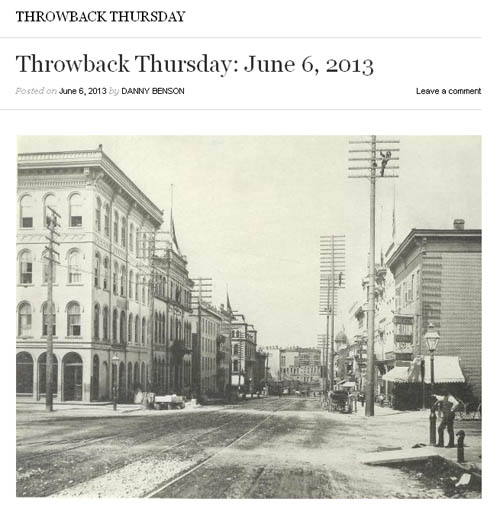The Milwaukee County Historical Society had a photo on their blog not too long ago showing Mason Street looking west of Broadway taken during the 1880’s. The exact same photo was used in this article from the Milwaukee Leader explaining the history of Newspaper Row. This was another article in the series by Frederic Heath on Milwaukee’s early history.
DO YOU REMEMBER? Newspaper Row Back in the ’80s
Milwaukee Leader, February 19, 1920
BY FREDERIC HEATHTo about 1910, Milwaukee still had a newspaper row. It was located on Mason St., below Broadway. Many newspapers were born there, nursed at the usual terrific expense and then sent upon their way. Some died aborning and some scarcely survived teething time.
In the accompanying view, this portion of Mason St. is shown as it looked in the late ’80s. About all that remains intact today is the building at the corner in the left side of the picture, now the home of the Kuryer Polski, and the old Kirby house at the corner of East Water St. Across from the Kirby is he old Brodhead Blk., now replaced by the First National Bank skyscraper.
Papers Combine.
The Kuryer Polski building formerly was the home of the German Herold. The building was erected by the publisher, W.W. Coleman, who was an able man in his line, and built up a tremendous business with many different editions and auxiliary publications. His greatest competition came from the Germania of George Brumder, then published at West Water and Cedar Sts. Eventually the papers were consolidated.
Next to the Herold Bldg. is seen the old Sentinel Bldg. In its business office for years one of the head clerks was William George Bruce, secretary of the Commerce Association. Editors and reporters were on the second floor and the printers on the top floor.
Across the street with the old Daily News office – not the Daily News of more modern times, but the Democratic organ of which Col. E.A. Calkins was for a time editor. A door or so further east was the old See Bote building, P.V. Deuster’s establishment.
Fight Changes Names.
A famous newspaper fight of those days transformed The News into the Republican and News, with Horace Rubins as editor, and eventually “got” The Sentinel, the name of which was changed for a time by the consolidation to Republican and Sentinel. From the old Republican and News office, across the street, Dr. E.W. Magan, as editor, issued a small afternoon daily called The Daily Dispatch, but it did not live long.
On the same side of the street, across the alley further west, where Marnits the Tailor now is located, there was located the Sunday Telegraph, started by Calkins and with which Col. J.A. Watrous was later identified. The type was set on its own premises on the second floor and the printing done in the basement of the Herold Bldg.
A door or two west of The Telegraph Bldg, with the old Freie Presse Bldg, a paper that is now but a memory, along with its editor, whose name was Siegl.
Old Haunts Recalled
Next to the See Bote office was the old Kahlo saloon, a veritable newspaper man’s home, while at the corner, seen at the right side of the picture, there was the old Quiet House of Adam Roth, also a haunt for newspaper men. On the top floor the Press Club had its quarters in those days. The building is now replaced by a high structure.
The list of newly born newspapers would not be complete without mention of The Daily Journal. It first saw the light from a room near the corner of The Herold, or Kuryer Polski Bldg., the windows of which appear in the picture. Lute Nieman, former managing editor of The Sentinel, was the editor, and the financial angel was Mike Kraus. Nieman and his assistant, William Bowdish, sat about a long table, grinding out as sensational yellow stuff as their imagination permitted, and the paper had a tough reputation during the time it was “catching on.” How Nieman and Bowdish managed to live has never been explained. Later on, Niemann married into a wealthy family and The Journal became very respectable.
Times Have ChangedMason St. o’ nights is tame and quiet now, but in the real days of Newspaper Row it was noisy with printers, racing printer devils, clattering mail wagons, boys with handcarts filled with mail bags and reporters darting about or foregathering in the establishments already named. It was the ceaseless clank of old style newspaper presses, and over all the smell of printers ink that is anise to the nostrils of the newspaper man.
But all this is gone. Newspaper Row is scattered. The city is big and newspaper methods have changed.
